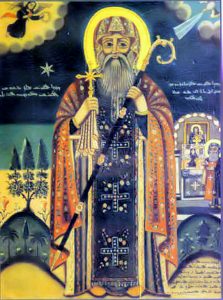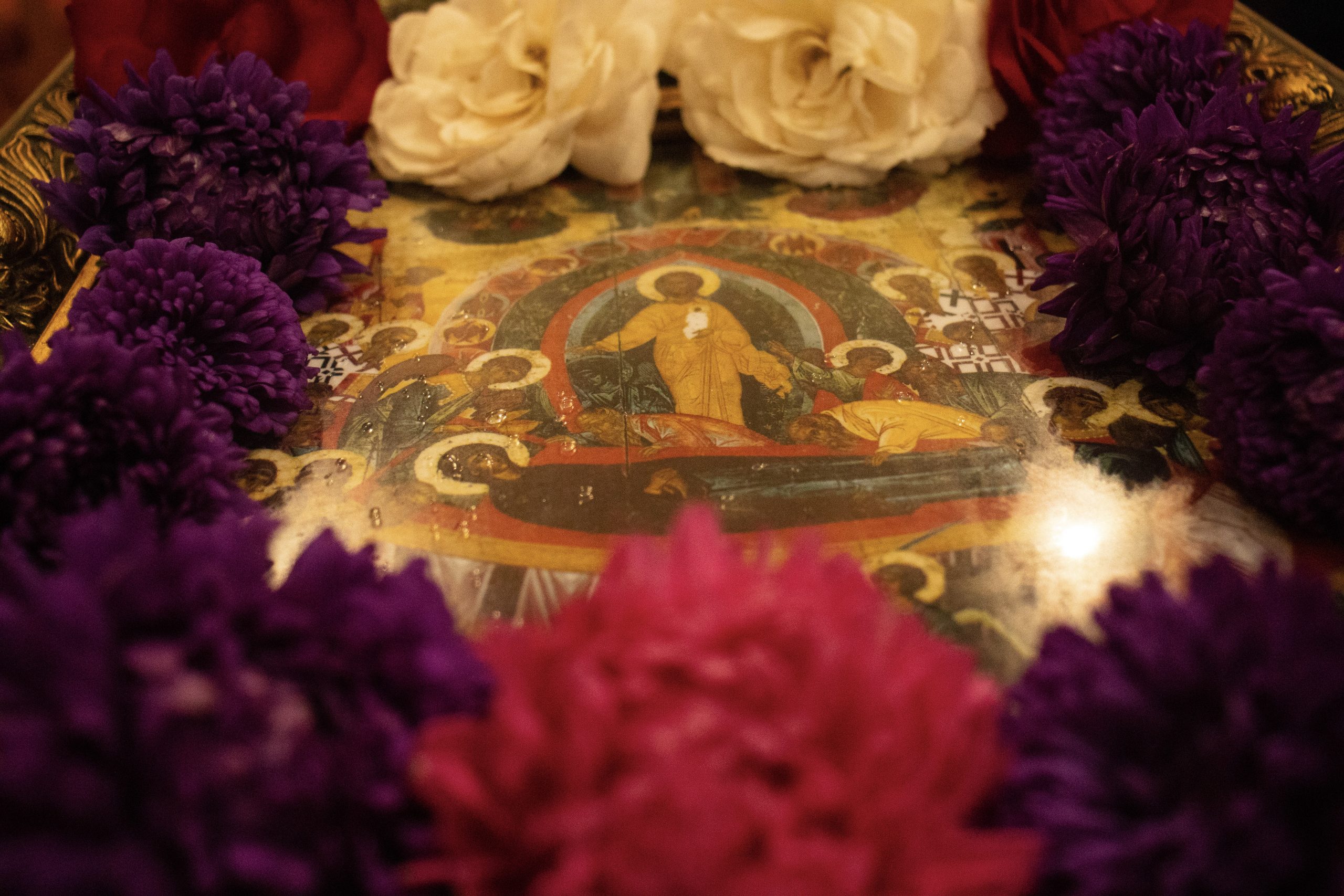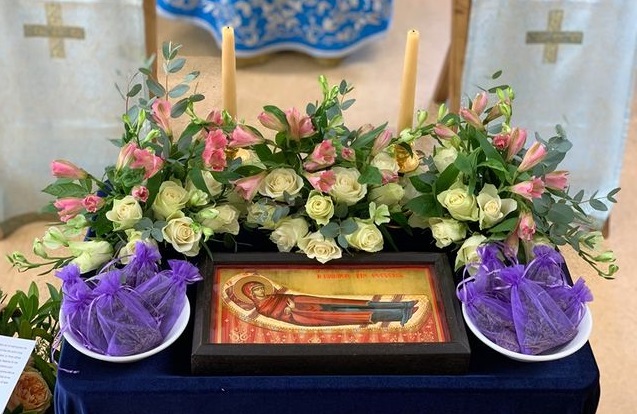
Dear brothers and sisters, greetings on this feast of the Dormition of the Most Holy Mother of God.
On this Summer Pascha, we celebrate the falling-asleep and resurrection of the Theotokos as the firstborn of the children of Adam and Eve, truly risen in body and soul, and assumed into the glory of the Kingdom of Heaven.
As the Hodegetria, ‘she who shows the way’, the Virgin is glorified in the totality of the resurrection, going physically as well as spiritually before the faithful-departed of every generation into the radiant eternity of the Eighth Day, which shall have no end.
Despite the heavenly nature of this feast, we are sometimes so earth-bound as we look at the plashchanitsa and icon.
Though mindful of the Lord taking His Mother – body and soul – into heaven, and though rejoicing at the empty tomb in Gethsemane, we often fail to reflect on the celestial joy of the glorious reception of the Mother of God into heaven.
In his poetic homily for the feast, Mar Jacob of Serugh reminds us that it is not only the company of the apostles that gathers at the Dormition of the Mother of God, but also the whole throng of the angelic hosts, who rejoice at her translation from death to life.
“Ranks and companies, also choirs of the sons of light; a clamour of watchers and a multitude of burning flames.
Fiery seraphim with wings closely covered by flames, with legions and their heavenly divisions.
Mighty cherubim who were yoked beneath his throne are moved by wonder to give praise with their Hosannas.
Followers of Gabriel, a glowing fiery multitude, and variously transformed in their natures.
Followers of Michael full of movement in their dissent, feasting, rejoicing, making merry this day with their Alleluias.
Heaven and the air of glory were filled with celestial beings, who journeyed and came down to the place of earth.”

Mar Jacob then turns to the saints of the Old Testament – the patriarchs, prophets, judges, kings and righteous ones who are not only the forefathers of Christ, but also of the Mother of God, through whom the Saviour was clothed in the flesh of Adam in His Incarnation.
By the victory of the Cross, Christ harrowed hell and stripped it of the righteous held by the chains and shackles of death, but it was only in spirit that their exodus led them from death life, and from the depths of Hades to the heights of heaven.
As they behold the full realisation of the resurrection, which they still await, Mar Jacob paints a poetic picture of their rejoicing as they see their daughter according to the flesh enter Heaven in that very flesh that has been received from them as her forebears.
“On this day Adam rejoices and Eve his wife, because their daughter rests in the place where they are gathered.
On this day the righteous Noah and Abraham rejoiced that their daughter has visited them in their dwelling-place.
On this day Jacob, the honourable old man, rejoices that the daughter who sprouted from his root has called him into life.
On this day the twelve just sons of the lame one rejoiced greatly and are glad in that she visited them.
On this day let also Judah rejoiced greatly, for behold the daughter who has given life, went forth from his loins.
On this day let Joseph rejoice in the great Moses, for one young maiden has called all mankind to life.
On this day let Aaron rejoice in Eliezar and all the tribes of the sons of Levi with their priesthood.
On this day let David the renowned forefather rejoice, because the daughter who was from him, has placed a glorious crown on his head.
On this day let Samuel rejoice with Jeremiah, because the daughter of Judah dropped dew on their bones.
Come Ezekiel, trained in prophetic revelation, if the thing that has occurred is described in your prophecy.
On this day let also Isaiah the prophet rejoice, because she whom he prophesied, behold she visits him in the place of the dead.
On this day all the prophets lifted their heads from their graves, because they saw the light which shone forth on them.
They saw that death is disquieted and flees from within them; and that the gates of heaven and the depths of the earth are opened again.”
Despite their greatness, these Old Testament saints only encountered God in veiled-appearances, types and shadows, with the Lord telling Moses, “Thou canst not see my face: for there shall no man see me, and live.”
In the harrowing of hell they spiritually beheld the Lord, whose body rested in the sepulchre even as He descended in soul to liberate their souls from death. In his Ascension, they – abiding in heaven awaiting the physical resurrection – beheld Him in His glorified flesh.
In their earthly sojourn, they had prophetically looked forward through the centuries to the virgin-mother, the rod of the root of Jesse, who would bear Immanuel – God with us.
In the glory of the Dormition and Assumption they welcomed their daughter, whose childhood entrance into the Holy of Holies of the Temple foreshadowed this day, when she entered the eternal sanctuary on high, following her Son’s translation of glorified human-nature to the right hand of the Father in his Ascension.
Though the forefathers, like all of the departed other than the Theotokos, must await the fulness of the resurrection, they rejoiced with the bodiless powers of heaven as they witnessed her Assumption as the fulfilment of the promise that they await.

With the passing of the centuries, new generations of the faithful are added to the synaxis of angels and humans who celebrate the heavenly translation of the Mother of Life, who leads us from death to life, and our own aspiration to the glorious reality of the Dormition and Assumption demands that we look to the example of the Mother of God in our hope to follow her heavenward-journey.
Striving to embrace the simplicity, humility, purity and God-centred obedience of her life, and imitating her by bowing before the Lord’s will each day, we must constantly echo her words, “Be it unto me according to Thy word”, whilst obeying her command at the marriage of Cana, “Whatsoever he saith unto you, do it.”
Just as her selfless life always pointed to the Saviour, so that she reflected Him as the moon reflects the light of the sun, His teachings and life-in-Him must be the existential reality and narrative of our lives, reflected and realised in each thought, word and deed.
If we are prepared to follow her example, the Theotokos already shows us the way from death to life, and from all that is earthly, temporal and transitory to the eternal glory of heaven, where the saints rejoice – radiant in the resurrection of Christ for all eternity.
Striving to emulate the Mother of God, and to follow her, let us struggle to mount the heights of heaven, rejoicing in the words of Mar Jacob “that death is disquieted and flees… and that the gates of heaven and the depths of the earth are opened again.”
Amen.
